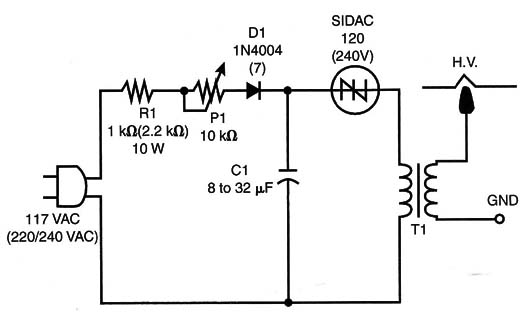Silicon diodes for alternating current (SIDACs) are negative-resistance devices with characteristics similar to those of a neon lamp. The main difference is that they are solid-state devices that, When triggered, can conduct currents.
A relaxation oscillator, such as the one used in the SCR version (ART244E), can be made easily, as we can see in Fig-1.

The circuit can be powered from 117 VAC or 220/240 VAC according to the used SIDAC. The operating principle is simple to understand: The C1 capacitor charges across R1/P1 until the trigger voltage of the SIDAC is reached. When triggered, the capacitor discharges across the primary coil of the transformer, producing a high-voltage pulse in the secondary coil.
The primary coil of the transformer is made in the same manner as in the project using the SCR: 8 to 12 turns of common plastic-covered wire. You can also replace the flyback transformer With a car ignition coil in this project as you might have done in the SCR project (ART244E).
SIDAC - NTE7419 (110 V), K1200 G (110 V), or K24OOG (220 V)
D1 - 1N4004(7) silicon rectifier diode
R1 - 1 k x 10-watt (2.2 k x 10-watt) wire-wounded resistor
F1 - 10 k wire potentiometer
C1 - 8 to 32 µF x 200-volt (400-Volt) electrolytic capacitor
T1 - Flyback transformer (see text)
Power cord, terminal strip, box, knob for P1, etc..
Values between brackets are for the 220/240 VAC power line.



